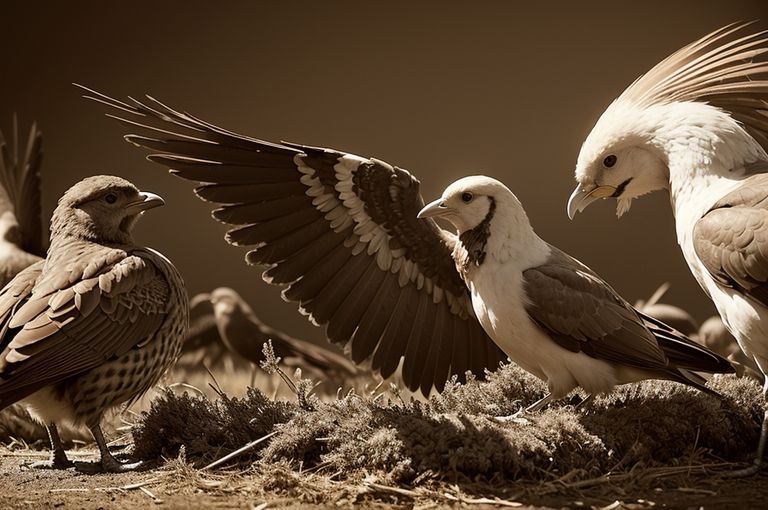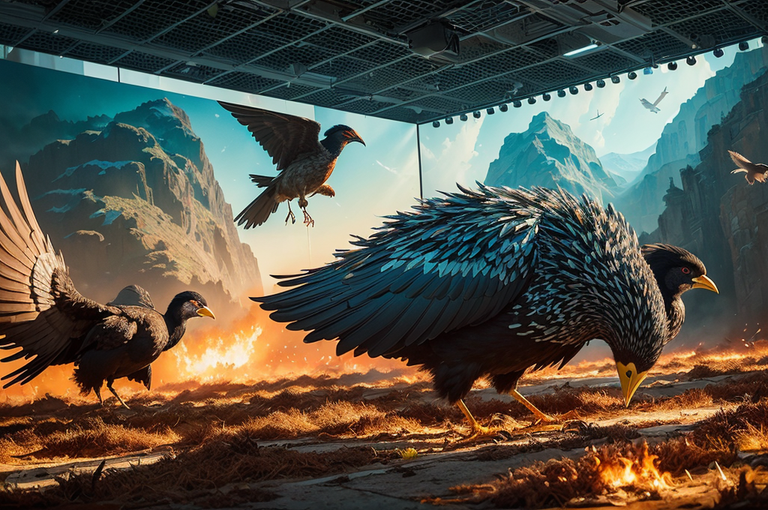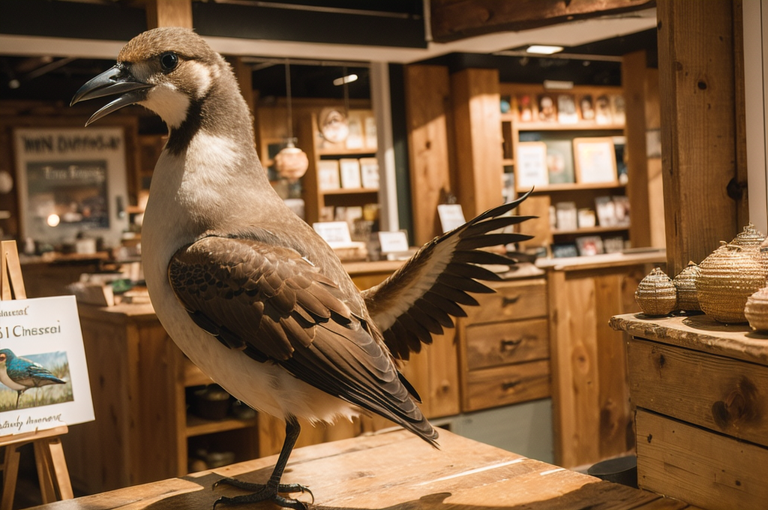Understanding Avian Influenza: Its Different Strains, Spread, and Impact on Birds and Other Mammals

The article discusses various Avian Influenza strains, their impact on bird species and other mammals, spread mechanisms, and disease control measures. It also explores AI’s subtypes and their varying severity on domestic birds.
Understanding The HPAI Virus
Awakening to the dawn chorus of wild birds avian flu frequencies often drift into my consciousness. While their songs fill the air with an uncanny symphony, the underlying issues they might be facing are far from melodious. One such concern is the Highly Pathogenic Avian Influenza (HPAI), a formidable foe of our feathered friends.
Distinguishing the HPAI Virus
The HPAI Virus, unlike the standard strains of avian influenza, is menacing for both domesticated poultry and wild birds. More alarmingly, it at times jumps the interspecies barrier, targeting humans.
Tracing the Eurasian Lineage HPAI
Tracing the lineage of the virus gives an ostensible roadmap of unaudited travels—spanning from Europe and Asia and most recently journeying to North America in late 2021. This opens up an ominous theatre of viral operations, affecting not just our backyard poultry but the diverse wild bird community as well.
Discussing the Bird Flu (H5N1) strain
And while we address avian ills, the Bird Flu (H5N1) strain deserves a potent attention. This particular strain has been responsible for diffusing itself across continents, impacting several bird species and encroaching some mammals a testament that it is not something to be taken lightly.
The theatrics of the influenza, like an unwanted guest, have battled our avian allies, creating a web of concern and curiosity. As we deepen our understanding and responses to these maladies, my hope is to shed light on these issues, not just as an observer but to stir the curiosity in all of us. It is our shared responsibility to protect nature’s beautifully feathered concert attendees.

The Spread Of The Virus
As an observer of nature’s feathered populace and a scholar navigating the wild frontier of avian research, I seek to unpack the curious nuances of the avian flu’s transmission. 🦠
Analysis of the Means of Spread
The virus, much like our feathered friends in the wild, seems to have its own form of frequent flying. It’s primarily shed in the feces of wild birds and spreads through ingestion. The expansiveness of its reach, indeed, mirrors the very dynamism and fluidity of the avian world. An unsought shadow, reflecting one of the least heralded aspects—avian flu in wild birds.
Understanding the Role of Migration
A spectacle that has held my fascination, migration paints a grand tableau of nature’s harmony. Yet, migration also harbors the darker tale of the influenza virus’s spread. As our feathered travelers journey across continents, they unknowingly carry the burdensome passenger of the virus, painting a mosaic of avian flu across lands.
Insights into Trade as a Medium of Spread
Trade too dons the mask of an unsuspecting medium of proliferation. As the bounty of poultry products exchange hands globally, the virus moves clandestinely from one corner of the earth to the other. Each infected poultry product, a ticking time bomb, ready to add another dot to the sprawling painting of this globally resonating pandemic.
With each flutter and flap, the all encompassing network of avian life and its intertwined activities reveal a canvas that is at once beautiful and alarming. Intriguing in its complexity, but intense in its implications for the spread of avian flu in wild birds. The silent spread of this virus through unsuspecting mediums serves as a grim reminder of the delicately balanced existence of our feathered cohabitants.

Control And Management Of The Disease
Awake with the lark, I find myself pondering proactive measures in detecting and containing viruses among our feathered friends. Observing the patterns of these mystical creatures, understanding their complex behaviors, we can predict and decipher abnormalities in their conduct that hint towards the possible onset of bird flu wild birds could be grappling with.
Exploring Proactive Measures for Virus Detection
Like the wise old owl, we must constantly strive to be vigilante and proactive in the virus detection realm. Profound knowledge and preemptive measures can be the difference between containment and catastrophe. Conducting regular health checks in hotspots, leveraging technology for constant monitoring, and constructing containment measures for potential zones of outbreak are key.
Understanding the Importance of Timely Communication and Accurate Diagnosis
Effective communication twinned with precise diagnosis lays the groundwork for robust control. It’s akin to the chorus of starlings at dusk harmonious synchronization proves vital. Emphasizing prompt reporting and feedback of lab findings, fostering a seamless flow of information between veterinary and wild bird communities, and investing in accurate, rapid diagnostic techniques, are all part of this communication symphony.
Discussing Surveillance of Bird Health, Behavior, and Habitat
Penetrating into the chords of my persistent pursuit for avian truth, surveillance of bird health, behavior, and habitat is essential. Observing changes and anomalies, similar to following a diverse species migratory pattern, can give us profound insight into detecting possible virus outbreaks.
In the grand scheme of things, it’s a concert. An orchestra of proactive measures, timely communication, and constant surveillance, that can help us manage and control diseases better. Each element, interlinked, resonating in unison towards fostering healthier habitats for our sky dancers.

Impact And Variability Of AI Virus
As an ardent observer of the avian world, while at wild birds unlimited montgomery, I’ve noted the devastating cataclysms the Avian Influenza (AI) virus wreaks upon a myriad of bird species. The severity of affliction the virus ascends to, often leading to significant morbidity and mortality, paints a chilling picture of a silent predator amid our airborne companions.
The Impact on Various Bird Species
From the humble sparrow to majestic eagles, no species seems exempt from this invisible threat. It’s like watching a beautiful ballet performance, only to see dancers falter one by one, their rhythmic flight crippled by unseen predators. The omnipresence of this threat underscores the intricate complexities of our ecosystem and the precarious balance it hangs on.
Understanding Different AI Subtypes
AI itself is not a monolith. Like the myriad species it affects, the virus too exhibits a broad spectrum, manifesting in multiple subtypes. Classified by Hemagglutinin and Neuraminidase protein groups, these subtypes show varying severity in domestic birds. Unraveling these nuances, akin to identifying different bird songs, has been both challenging and enlightening—a testament to the enduring mystery of avian life.
AI Effects on Mammals
Our own kin in the mammalian realm are not immune to this threat. Certain AI strains have shown the capacity to leap species, reminiscent of the swift flight of the peregrine falcon. Once thought exclusive to birds, these strains now pose a risk to our furry brethren, showing neurological signs in affected mammals, as witnessed in Wisconsin.
Examining this labyrinth of viral variability, one must recognize the interdependence within our natural world. From varied bird species to mammals, we are all woven into this intricately fascinating tapestry of life. The ripple effects of the AI virus symbolize the delicate balance that characterizes nature’s grand dance—a dance we are all part of.
Key Takeaways
Review of the Severity and Reach of the HPAI Virus
It is of paramount importance to grasp the sheer magnitude and impact the avian flu, particularly the High Pathogenic Avian Influenza (HPAI) virus, casts over the lives of wild birds. As I’ve witnessed in my studies, this strain of bird flu possesses a virulence that transforms majestic wings into fatal vulnerabilities in a matter of days. In a nutshell, wild birds avian flu is a subject we ought to take very seriously.
Understanding the Spread of the Virus
Observing the dawn take flight is a marvel; however, it is equally shattering to realize the harm that each flight might carry along. This avian flu in wild birds can hitch a ride, relentlessly spreading upon the wings of migratory hosts, or it could seep into our own backyards through infected poultry products. The bird flu wild birds carry is not tied down by geographic barriers; it ebbs and flows with them, spanning oceans, mountains and prairies. I have seen this happen just steps from my home at Wild Birds Unlimited in Montgomery.
Emphasis on Disease Control and Management
Equipped with this understanding, we can no longer remain idle spectators. It is crucial to evolve our actions from merely admiring feathered beauty, to vigilant disease monitoring and control. Insisting on careful observation of bird behavior and scrutiny of their habitats, for instance, can be a major step towards effective avian flu management. Thus, for the love of our winged friends and our fascination with avian wonder, let us stand up, pay heed, and walk the path of responsibility and awareness. In the beautiful world of birds, it is our duty to ensure every species has its shot at a safe, healthy flight.


